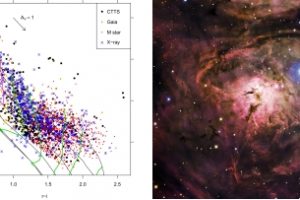The chronology of star formation in NGC 6530 unveiled thanks (also) to the Gaia satellite

Stars form from the gravitational collapse of large interstellar clouds. During the process, the clouds fragment in smaller clouds, forming clusters and associations of stars counting from few tens to several hundred thousands stars. The star formation process typically is not a monolithic process, e.g. with a single large event of star formation occurring rapidly and forming all the stars populating the star forming region. Instead, it is typically a long phenomenon with a complex chronology, with more interconnected events of star formation.
The study of the sequence of star formation is a hard task. It is in fact necessary to obtain a reliable list of stars associated with a given star forming region, with a small contamination from stars lying along the line of sight but not being connected with the given region. Then, the age of each single star must be found, typically from the comparison between the observed photometry with theoretical models of stellar evolution which connect observable stellar properties with their ages.
The team led by the astronomer F. Damiani (INAF – Astronomical Observatory of Palermo) studied the sequence of star formation in the young cluster NGC 6530 and its surroundings. The list of 3675 candidate cluster members was compiled by merging the results of several diagnostics aimed at identifying young stars associated with the cluster. In particular, the team deployed a method developed by astronomers of INAF-OAPA useful to select M-type stars associated with stellar clusters, together with the second Data Release of the ESA satellite Gaia. This satellite provides dynamics and distances of stars with unprecedented accuracy, allowing to identify stars associated with stellar clusters. Then, from the comparison between the observed photometry with existing evolutionary models, the team found the age of the candidate members and studied the chronology of star formation in the cluster. This research indicates that the oldest stellar population (4-5 million years old) is mainly clustered in the core of NGC 6530, with the average stellar age decreasing toward the cluster outskirt. Besides, stellar dynamics obtained from Gaia suggest that the cluster parental cloud collided with the Galactic plane about 4 million years ago, likely triggering the first events of star formation. The research is described in the paper: “Wide-area photometric and astrometric (Gaia DR2) study of the young cluster NGC 6530“, recently appeared on Astronomy & Astrophysics with the collaboration of the INAF-OAPA astronomers L. Prisinzano, G. Micela e S. Sciortino.
The figure (link) shows a color-magnitude diagram of all the candidate cluster members, marked with different symbols accordingly to the diagnostic used to select them. Also the 1, 3, 10, 30, 100 Myrs isochrones (the loci of stars with different mass but given age) and some stellar tracks (the loci of stars with different age but given mass) are shown.
by Mario Giuseppe Guarcello ( follow mguarce)
